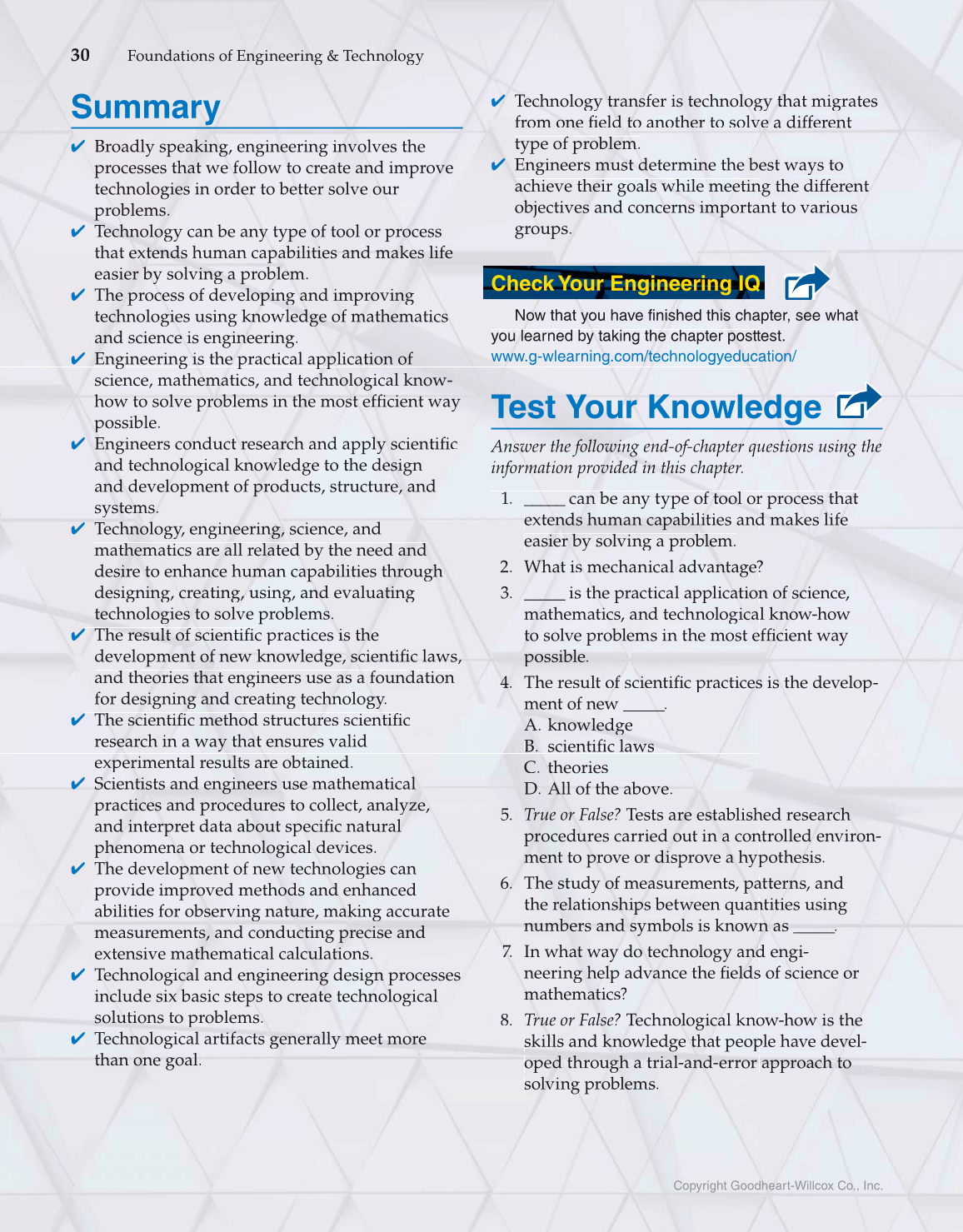30
Foundations of Engineering & Technology n
Copyright Goodheart-Willcox Co., Inc.
Summary
✔ Broadly speaking, engineering involves v the
processes that we follow to create and d improve
technologies in order to better t solve our o
problems.
✔ Technology can be any type of tool or r process
that extends d human capabilities and makes m life
easier by solving a problem.
✔ The process of developing and improving o
technologies using knowledge of mathematics t s
and science is engineering.
✔ Engineering is the practical applicatio on of g g p p p
science, mathematics, and technological i know-
how to solve problems in the most efficient way fi
possible.
✔ Engineers conduct research and apply scientific fi
and technological knowledge to the design d
and development of products, structure, u and
systems.
✔ Technology, engineering, science, and d
mathematics are all related by the need e and
desire to enhance human capabilities through
designing, creating, using, and evaluating a
technologies to solve problems.
✔ The result of scientific practices is the e fi
development of new knowledge, scie entific laws, fi
and theories that engineers use as a foundation o
for designing and creating technology. y
✔ The scientifi c method structures scientific n fi fi
research in a way that ensures valid
experimental results are obtained.
✔ Scientists and engineers use mathematical a
practices and procedures to collect, analyze, n
and interpret data about specific natural u fi
phenomena or technological devices.
✔ The development of new technologies e can
provide improved methods and enhanced a
abilities for observing nature, making g accurate
measurements, and conducting precise and
extensive mathematical calculations.
✔ Technological and engineering design n processes
include six basic steps to create technological n
solutions to problems.
✔ Technological artifacts generally meet more
than one goal.
✔ Technology T transfer is technolog gy that migratesi
from one fi eld to another to solv ve a different fi
type of problem.
✔ Engineers must determine the best ways to
achieve their i goals while w meeting n the different
objectives and concerns important a to various
groups.
Check Your Engineering IQ
Now that you y have finished s this chapter, a see what
you learned by y taking the chapter posttest. t
www.g-wlearning.com/technologyeducation/
Test Your Knowledge
i using the Answer the following end-of-chapter questions u
information provided in this s chapter.
process that 1. _____ can be any a type of tool or r
makes life extends human capabilities and d
easier by solving a problem.
2. What is s s s mechanical advantage? ?
of science, 3. _____ is the t h practical application a n
know-how mathematics, and technological
efficient to solve problems b in the most e way y fi
possible.
4. The result of f scientific practices s is the develop- fi
ment of new e _____.
A. knowledge
B. scientific laws fi
C. theories
D. All of the above.
5. True or False? hed research Tests are establi sh
environ- procedures carried out in a controlled n
ment to prove or disprove a hypothesis.p
and 6. The study of measurements, patterns, a
using the relationships between quantities n
as _____. numbers and symbols is known n
engi- n 7. In what way do technology and d
neering help advance the fields of science s or s fi
mathematics?
8. True or False? w is the Technological a know-how o
have devel- skills and knowledge that people p
approach to oped through a trial-and-error
solving problems.
